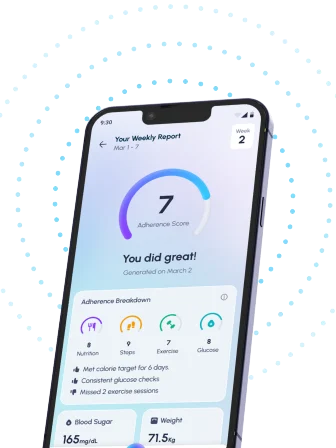Table of Contents
- Understanding Restless Legs Syndrome and Diabetes
- Effective Treatments for RLS with Diabetes
- Managing RLS Symptoms: Home Remedies and Lifestyle Changes
- The Link Between Diabetes and Restless Legs Syndrome
- Finding Relief: Diagnosis and Treatment of RLS in Diabetics
- Frequently Asked Questions
- References
Living with diabetes often presents unique challenges, and for some, that includes the added discomfort of restless legs syndrome (RLS). The persistent urge to move your legs, often accompanied by uncomfortable sensations, can significantly impact sleep and overall well-being. This is why we’ve created Managing Restless Legs Syndrome with Diabetes: A Comprehensive Guide, designed to help you navigate this dual diagnosis. We’ll explore effective strategies for managing both conditions simultaneously, offering practical advice and insights to improve your quality of life. Let’s dive in and discover how you can find relief and better manage your symptoms.
Understanding Restless Legs Syndrome and Diabetes
Restless legs syndrome (RLS), characterized by an irresistible urge to move the legs, often accompanied by uncomfortable sensations, is a prevalent condition affecting millions globally. Its impact is significantly heightened for individuals with diabetes, a condition particularly common in India and other tropical countries. The connection between these two conditions is not fully understood, but research suggests a potential link through shared risk factors like iron deficiency and nerve damage. Managing RLS effectively is crucial for diabetics, as persistent discomfort can negatively affect sleep quality, leading to reduced energy levels and potentially impacting blood sugar control.
The Increased Risk for Diabetics
Diabetics are at a higher risk of experiencing complications like peripheral neuropathy, nerve damage affecting the legs and feet. This nerve damage can exacerbate the symptoms of RLS, making the condition more severe and difficult to manage. Furthermore, the nearly 15% lifetime risk of developing foot ulcers in diabetics, as highlighted by medical research, underscores the importance of addressing RLS symptoms. Untreated RLS can lead to increased restlessness and accidental injuries, potentially contributing to the development of foot ulcers and increasing the risk of amputation. This is especially concerning in regions with limited access to advanced healthcare. The connection between diabetes and foot problems is complex, and you might find it helpful to read more about Does Diabetes Cause Swollen Feet? Understanding the Connection.
Regional Considerations in RLS Management
In India and other tropical countries, access to specialized healthcare and advanced treatments for RLS might be limited. Therefore, focusing on lifestyle modifications and readily available therapies becomes even more critical. Prioritizing good sleep hygiene, regular exercise appropriate for diabetic patients, and maintaining a balanced diet rich in iron are crucial steps. Consulting with a healthcare professional for personalized advice tailored to your specific needs and regional context is essential for effective RLS management in the context of diabetes. Remember, proactive management of RLS can significantly improve your overall well-being and reduce the risk of diabetes-related complications. Experiencing cold feet could also be a symptom warranting attention; learn more by reading Are Cold Feet a Symptom of Diabetes? What You Need to Know.
Effective Treatments for RLS with Diabetes
Managing restless legs syndrome (RLS) alongside diabetes presents unique challenges. The discomfort of RLS, characterized by an irresistible urge to move the legs, is often exacerbated by diabetic neuropathy and sleep disturbances. This is particularly crucial in hot and humid climates prevalent in many Indian and tropical countries, where sleep quality can already be impacted by environmental factors. The added burden of sleep apnea, a condition linked to a 70% increased risk in individuals with diabetes, further complicates RLS management.
Lifestyle Adjustments for RLS Relief
Adopting a healthy lifestyle is paramount. Regular exercise, a balanced diet rich in iron and magnesium (often deficient in individuals with diabetes), and stress reduction techniques are essential. Prioritizing sleep hygiene, maintaining a consistent sleep schedule, and creating a cool, dark, and quiet sleep environment are vital, especially given the impact of heat in tropical regions. Avoiding caffeine and alcohol before bed is also crucial. A balanced diet, as discussed in Safe and Effective Dietary Supplements for Diabetes Care, plays a significant role in managing both diabetes and RLS.
Medical Management of RLS in Diabetes
Your doctor may prescribe medications to help control RLS symptoms. These might include dopamine agonists or alpha-2-delta calcium channel ligands. It’s crucial to discuss all medications with your physician, as some diabetes medications can interact with RLS treatments. Regular monitoring of blood sugar levels is vital for effective diabetes management, which in turn influences RLS symptom severity.
Seeking Expert Care in India and Tropical Countries
For individuals in India and tropical countries, accessing specialized care for both diabetes and RLS is crucial. Consult a physician experienced in managing both conditions to develop a personalized treatment plan. Consider seeking advice from neurologists or sleep specialists familiar with the unique challenges posed by the climate and prevalent health conditions in your region. Early intervention and a proactive approach are key to improving quality of life. Remember that prioritizing quality sleep in managing diabetes is crucial for overall well-being and can significantly impact RLS symptoms.
Managing RLS Symptoms: Home Remedies and Lifestyle Changes
Restless legs syndrome (RLS) can significantly impact quality of life, and it’s especially important to manage it effectively, particularly for individuals with diabetes. Many cases of Type 2 diabetes, a condition often linked to RLS, can be prevented or delayed through lifestyle changes, as highlighted by the Government of India (source). This underscores the crucial role of proactive management for both conditions.
Home Remedies for RLS Relief
Several home remedies can help alleviate RLS symptoms, especially in hot and humid climates prevalent in India and other tropical countries. Regular gentle exercise, like yoga or Tai Chi, can improve circulation and reduce RLS symptoms. A warm bath before bed can also soothe restless legs. Furthermore, maintaining a consistent sleep schedule and creating a relaxing bedtime routine are vital. Addressing underlying nutritional deficiencies, common in some tropical regions, through a balanced diet rich in iron and magnesium is also crucial. For instance, ensuring proper digestion is crucial for nutrient absorption; issues such as lumbar spondylosis, while not directly related to RLS, can sometimes indirectly impact overall health and well-being, highlighting the importance of a holistic approach to health.
Lifestyle Modifications for Long-Term Management
Beyond home remedies, significant lifestyle changes are key to managing both RLS and diabetes. Maintaining a healthy weight is paramount, as obesity increases the risk of both conditions. A diet rich in fruits, vegetables, and whole grains, alongside regular physical activity, is essential. Limiting caffeine and alcohol intake, particularly in the evenings, can significantly improve sleep quality and reduce RLS symptoms. Regular check-ups with your doctor are essential for monitoring both conditions and adjusting treatment plans as needed. Addressing digestive issues promptly, as discussed in our article on home remedies for loose motion, can also contribute to overall health and well-being, impacting factors that may indirectly influence RLS symptoms.
Remember: Consulting a healthcare professional is vital before starting any new treatment or making significant lifestyle changes, especially if you have diabetes or other pre-existing conditions. Early intervention and a proactive approach to managing both RLS and diabetes are key to improving your overall health and well-being in India and other tropical regions.
The Link Between Diabetes and Restless Legs Syndrome
Understanding the Connection
Restless legs syndrome (RLS), characterized by an overwhelming urge to move the legs, often accompanied by uncomfortable sensations, affects a significant portion of the population. However, individuals with diabetes appear to be at a heightened risk. While the exact mechanism isn’t fully understood, several theories suggest a strong correlation. One contributing factor may be the impact of diabetes on the nervous system, potentially affecting nerve function and contributing to the uncomfortable sensations associated with RLS. This is particularly relevant in tropical and Indian climates, where diabetes prevalence is high.
The Role of Kidney Disease
The link between diabetes and RLS is further complicated by the increased risk of kidney disease in diabetic patients. Nearly 30% of individuals with diabetes develop diabetic nephropathy, a condition affecting kidney function. Impaired kidney function can lead to an imbalance of electrolytes and minerals in the body, which are known to influence nerve function and potentially exacerbate RLS symptoms. Managing blood sugar levels and kidney health is, therefore, crucial in mitigating RLS symptoms for individuals with diabetes in India and other tropical regions. This is further complicated by the high prevalence of Understanding the Link Between Diabetes and Obesity, which often accompanies diabetes.
Seeking Regional Expertise
It’s crucial to consult with healthcare professionals experienced in managing diabetes and its complications within the Indian and tropical contexts. They can provide tailored advice on managing both conditions effectively. Early diagnosis and proactive management of both diabetes and RLS can significantly improve quality of life and reduce the burden of these interconnected health issues. Don’t hesitate to seek specialized care to address your specific needs and concerns. For a better understanding of how other sleep disorders might interact with diabetes, consider reading our blog on The Connection Between Diabetes and Sleep Apnea.
Finding Relief: Diagnosis and Treatment of RLS in Diabetics
Restless legs syndrome (RLS) can significantly impact the quality of life, particularly for individuals already managing diabetes. The discomfort of RLS, characterized by an irresistible urge to move the legs, often intensifies at night, disrupting sleep and contributing to fatigue. This is further complicated for those with diabetes, as diabetic neuropathy, affecting 30-50% of patients, frequently presents with similar symptoms of pain and reduced mobility, making diagnosis challenging. Differentiating between RLS and neuropathy is crucial for effective treatment.
Diagnosing RLS in Diabetics
A thorough medical history, including a detailed account of your symptoms, is the first step. Your doctor will consider factors like the timing of symptoms (often worse at night or when at rest), the irresistible urge to move your legs, and any relief experienced with movement. Physical examinations and nerve conduction studies may be used to rule out other conditions, including diabetic neuropathy. Open communication with your doctor about your symptoms is vital for an accurate diagnosis.
Treatment Options for RLS in Diabetics
Treatment approaches vary depending on the severity of your RLS. Lifestyle modifications such as regular exercise, maintaining a healthy weight, and avoiding caffeine and alcohol are often recommended. In some cases, medications may be prescribed. These could include dopamine agonists, or other medications tailored to manage both RLS and co-existing conditions like diabetes. It’s crucial to discuss all medications with your doctor to manage potential interactions. Managing other aspects of your health, such as following a healthy diet, is also important. For instance, you might wonder Can Diabetics Eat Raisins? Learn About Their Impact to better understand dietary choices.
Finding Relief in India and Tropical Countries
Access to specialists and appropriate treatment for RLS can vary across regions. In India and other tropical countries, it’s important to seek consultation from a neurologist or diabetologist experienced in managing both conditions. Early diagnosis and a collaborative approach involving both your primary care physician and a specialist are essential for effective RLS management. Don’t hesitate to explore support groups and online communities for sharing experiences and coping strategies. Remember, effective management of RLS can improve sleep quality and overall well-being, significantly enhancing your quality of life. As you age, managing diabetes becomes even more critical. For insights and solutions, check out Managing Diabetes as You Age: Challenges and Solutions.
Frequently Asked Questions
Q1. What is the connection between restless legs syndrome (RLS) and diabetes?
People with diabetes, especially those in tropical regions like India, are more likely to experience RLS. While the exact reason isn’t fully understood, shared risk factors such as iron deficiency and nerve damage are thought to play a role.
Q2. How does RLS affect diabetics?
RLS significantly disrupts sleep in diabetics. Poor sleep worsens blood sugar control, increasing the risk of foot problems like ulcers and, in severe cases, amputation.
Q3. How can I manage RLS if I have diabetes?
Lifestyle changes are key: a diet rich in iron and magnesium, regular exercise, and good sleep hygiene. If these aren’t enough, a doctor experienced in managing both diabetes and RLS can prescribe medication.
Q4. Why is early diagnosis and treatment of RLS important for diabetics?
Early management is crucial because RLS worsens sleep and blood sugar control, leading to increased risks of serious complications. Addressing RLS promptly helps improve overall health and quality of life.
Q5. What are some challenges in managing RLS with diabetes?
Access to healthcare professionals specializing in both conditions can vary depending on location. Proactive management and consulting a doctor are essential to get the right care and reduce diabetes-related complications.
References
- A Practical Guide to Integrated Type 2 Diabetes Care: https://www.hse.ie/eng/services/list/2/primarycare/east-coast-diabetes-service/management-of-type-2-diabetes/diabetes-and-pregnancy/icgp-guide-to-integrated-type-2.pdf
- Children with Diabetes : A resourse guide for families and school. : https://www.health.ny.gov/publications/0944.pdf




